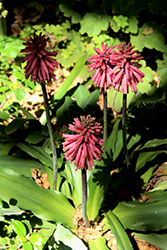It's all about ...
plants

Plant Height: 8 inches
Flower Height: 24 inches
Spacing: 14 inches
Sunlight:
![]()
![]()
Hardiness Zone: 9a
Other Names: Cape Lily, Sand Onion, Winter Red Hot Poker
Description:
Dramatic rose-pink bottlebrush type flowers rise in winter from a rosette of broad, strap-like glossy foliage that dies back in summer; a brilliant border or container plant for winter color; reduce moisture after blooming; divide when dormant
Ornamental Features
Forest Lily features bold spikes of rose tubular flowers with pink overtones and green tips at the ends of the stems from early to late winter. The flowers are excellent for cutting. Its large glossy sword-like leaves remain dark green in colour throughout the season. The dark red stems are very colorful and add to the overall interest of the plant.
Landscape Attributes
Forest Lily is an open herbaceous perennial with tall flower stalks held atop a low mound of foliage. Its relatively coarse texture can be used to stand it apart from other garden plants with finer foliage.
This is a relatively low maintenance plant, and should never be pruned except to remove any dieback, as it tends not to take pruning well. It is a good choice for attracting bees, butterflies and hummingbirds to your yard, but is not particularly attractive to deer who tend to leave it alone in favor of tastier treats. It has no significant negative characteristics.
Forest Lily is recommended for the following landscape applications;
- Mass Planting
- General Garden Use
- Container Planting
Planting & Growing
Forest Lily will grow to be about 8 inches tall at maturity extending to 24 inches tall with the flowers, with a spread of 18 inches. When grown in masses or used as a bedding plant, individual plants should be spaced approximately 14 inches apart. It grows at a medium rate, and under ideal conditions can be expected to live for approximately 10 years. As an herbaceous perennial, this plant will usually die back to the crown each winter, and will regrow from the base each spring. Be careful not to disturb the crown in late winter when it may not be readily seen! As this plant tends to go dormant in summer, it is best interplanted with late-season bloomers to hide the dying foliage.
This plant does best in partial shade to shade. It does best in average to evenly moist conditions, but will not tolerate standing water. To help this plant achive its best flowering performance, periodically apply a flower-boosting fertilizer from early spring through into the active growing season. It is not particular as to soil pH, but grows best in sandy soils. It is somewhat tolerant of urban pollution, and will benefit from being planted in a relatively sheltered location. This species is not originally from North America. It can be propagated by division.
Forest Lily is a fine choice for the garden, but it is also a good selection for planting in outdoor pots and containers. With its upright habit of growth, it is best suited for use as a 'thriller' in the 'spiller-thriller-filler' container combination; plant it near the center of the pot, surrounded by smaller plants and those that spill over the edges. Note that when growing plants in outdoor containers and baskets, they may require more frequent waterings than they would in the yard or garden. Be aware that in our climate, most plants cannot be expected to survive the winter if left in containers outdoors, and this plant is no exception. Contact our experts for more information on how to protect it over the winter months.
This plant is not reliably hardy in our region, and certain restrictions may apply; contact the store for more information.
